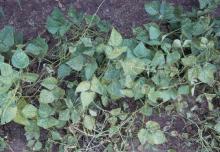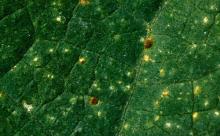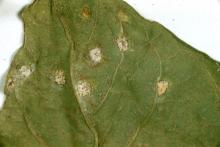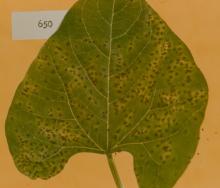Cause The fungus, Uromyces appendiculatus (formerly Uromyces phaseoli), causes rust. It has had minor importance for many years. When present, the disease is widespread in the major bean-growing areas of the Willamette Valley of Oregon. It is not known to be in Idaho. Disease is favored by moderate temperature and high humidity or moisture.
Symptoms In June, white blisters (pycnia) develop on leaves' upper surfaces. In 2 to 3 weeks, the underside of the blister (aecia) turns white and produces a white powder, the aeciaspores. In July, brown powdery spots (uredinia) appear on upper and lower leaf surfaces and petioles. If infection is severe, many leaves die and the crop is reduced. In August to September, black powdery spots (telia) appear on upper and lower leaf surfaces and petioles. Leaves die, and the crop is reduced. Besides leaves, rust attacks all other aboveground green portions of the bean plants.
Cultural control
- Plant resistant varieties.
- Rotate with non-host crops.
- Eliminate volunteer beans in other fields.
- Encourage decomposition of old bean debris.
Chemical control
- Carboxamide (Group 7) formulations are registered for use. Do not make more than two (2) sequential applications before alternating to a labeled fungicide with a different mode of action.
- Endura at 8 to 11 oz/A on 7- to 14-day intervals. Preharvest interval is 7 days. 12-hr reentry.
- Fontelis at 16 to 30 fl oz/A on 7- to 14-day intervals. Preharvest interval is 0 days. 12-hr reentry.
- Chlorothalonil products (Group M5) such as:
- Bonide Fung-onil is available for home gardens. H
- Bravo Ultrex at up to 2.7 lb/A. Do not apply within 7 days of harvest. Do not graze treated area or feed treated plant parts to livestock. 12-hr reentry.
- Echo 720 at 1.38 to 3 pints/A on 7-day intervals when disease threatens. Preharvest interval is 7 days. 12-hr reentry.
- Demethylation-inhibiting (DMI) Fungicides (Group 3) are labeled for use.
- Rally 40WSP at 4 to 5 oz/A on 7- to 10-day intervals. Application can be made on day of harvest. 24-hr reentry.
- Tebustar 3.6L at 4 to 6 fl oz/A on 14-day intervals. Do not apply within 7 days of harvest. 12-hr reentry.
- Tebuzol 3.6F at 4 to 6 fl oz/A on 14-day intervals. Do not apply within 7 days of harvest. 12-hr reentry.
- JMS Stylet-Oil at 3 to 6 quarts/100 gal water. Do not spray if temperature is below 50°F or above 90°F or when plants are wet or under heat or moisture stress. Good coverage is essential. 4-hr reentry. O
- Regalia (Group P5) at 1 to 4 quarts/A plus another fungicide on 7- to 10-day intervals. Does not benefit from the addition of an adjuvant. Preharvest interval is 0 days. 4-hr reentry. O
- Sulfur products (dust formulations that are 325 mesh or finer) containing at least 80% sulfur. Apply first as soon as lesions or spots appear. Apply at 20 to 36 lb/A, depending on the plants' size. Continue dusting at 7-day intervals until blossom time. Early dusting is especially important-apply sulfur before any rust is noticeable. Controlling rust by dusting is difficult if the disease becomes established in a planting.
- Strobilurin fungicides (Group 11) are labeled for use. Do not make more than one (1) application of a Group 11 fungicide before alternating to a labeled fungicide with a different mode of action.
- Headline at 6 to 9 fl oz/A prior to disease development on 7- to 14-day intervals. Preharvest interval is 7 days for pods, 14 days for forage and hay. 12-hr reentry.
- Quadris Flowable at 6 to 15.5 fl oz/A on 7- to 14-day intervals. May be applied the day of harvest. 4-hr reentry.
Note: Premixes are available for use.
- Miravis Neo (Group 7 + 3 + 11) at 13.7 fl oz/A. The first application should be applied before disease is established and no later than the onset of flowering. Apply on a 14-day interval. No more than two (2) applications per year. May be applied up to 14 days before harvest. 12-hr reentry.
- Quilt Xcel (Group 3 + 11) at 10.5 to 14 fl oz/A on a 7- to 14-day interval for no more than three (3) applications. Preharvest interval is 7 days. 12-hr reentry.
- Priaxor Xemium Brand (Group 7 + 11) at 4 to 8 fl oz/A. Do not make more than two (2) applications per season. Preharvest interval is 7 days. 12-hr reentry.
Biological control
- Sonata at 2 to 4 quarts/A on 7- to 14-day intervals for disease suppression. Can be applied up to and on the day of harvest. 4-hr reentry. O





